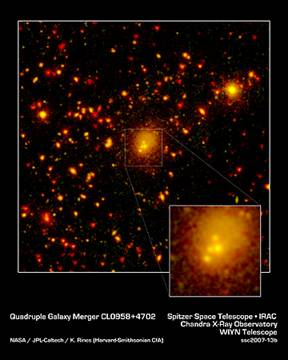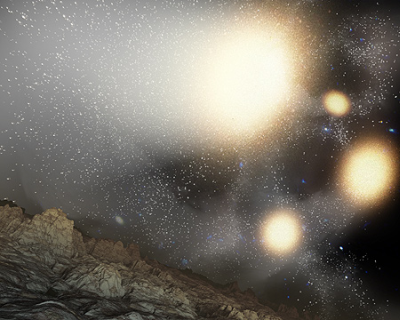07 August 2007

Four galaxies are slamming into each other and kicking up billions of stars in one of the largest cosmic collisions ever observed.
The clashing galaxies, pictured by NASA's Spitzer Space Telescope (SST), will ultimately merge, forming a gigantic galaxy up to 10 times as massive as our own Galaxy. This rare phenomenon provides an unprecedented insight into the formation mechanisms of the largest galaxies in the Universe.
"Most of the galaxy mergers we already knew about are like compact cars crashing together," said Kenneth Rines of the Harvard-Smithsonian Center for Astrophysics (CfA). "What we have here is like four sand trucks smashing together, flinging sand everywhere." Rines is principal author of a new article, due for publication in Astrophysical Journal Letters.
Encounters between galaxies are common in the Universe. Gravity causes some galaxies that are close together to interact and eventually coalesce over a period of millions of years. Stars in merging galaxies are flung around like sand, but as they are immensely spaced, they survive the impact. Studies show that our Galaxy will collide with our large cosmic neighbor, the Andromeda Galaxy in five billion years.
Mergers between one large galaxy and several small ones, called minor mergers, are well documented. For example, one of the most elaborate known minor mergers is occurring in the Spiderweb Galaxy, a massive galaxy that is capturing dozens of small ones in its gravitational "web". Astronomers have also observed "major" mergers among pairs of galaxies that are similar in size, but no major mergers between multiple hefty galaxies have been observed until now.
The new quadruple of interacting galaxies was discovered serendipitously during a Spitzer survey of a distant cluster of galaxies, nearly five billion light-years away, designated CL0958+4702. SST first detected an unusually large fan-shaped plume of light glowing around four elliptical galaxies. Three of the galaxies are similar in size to our Galaxy, while the fourth is three times larger.
Further analysis of the plume demonstrated it consists of billions of older stars flung out in an ongoing collision. About half of the stars in the plume will later be pulled back into the galaxies. "When this merger is complete, this will be one of the biggest galaxies in the Universe," said Rines.
The SST observations also show that the new merger lacks gas. Theorists predict that massive galaxies grow in various ways, including gas-rich and gas-poor mergers. In gas-rich mergers, the galaxies are soaked with gas that churns to form new stars. In gas-poor mergers no new stars are formed. Spitzer found only old stars in the quadruple encounter.

The night sky of a hypothetical planet, orbiting a star of the interacting quadruple
Credit: NASA/JPL-Caltech/T. Pyle (SSC)
"The Spitzer data show that these major mergers are gas-poor, unlike most mergers we know about," said Rines. "The data also represent the best evidence that the biggest galaxies in the Universe formed fairly recently through major mergers."
Some of the stars hurled in the titanic merger will be located in isolated areas outside the galaxies. Such abandoned stars could theoretically have planets. If so, the skies of these planets would be awesome, with fewer stars and more spectacular galaxies.
Rines and his collaborators used a large ground-based telescope to confirm that the four galaxies are entangled. They also used NASA's space-based Chandra X-ray Observatory to estimate the mass of the giant cluster of galaxies in which the merger was discovered. Another ground-based telescope was used to further study the plume.
Further Reading
Spitzer Spies Monster Galaxy Pileup
http://www.spitzer.caltech.edu/Media/releases/ssc2007-13/release.shtml
SST
http://www.spitzer.caltech.edu/spitzer/index.shtml
Aymen Mohamed Ibrahem
Senior Astronomy Specialist